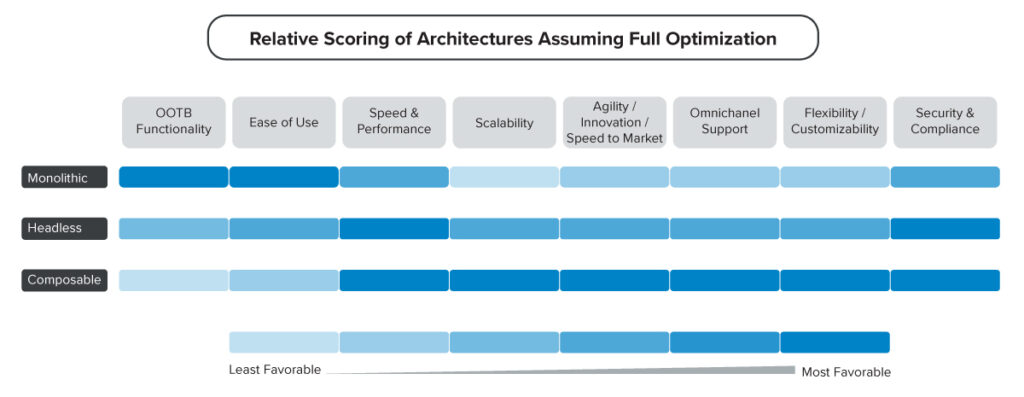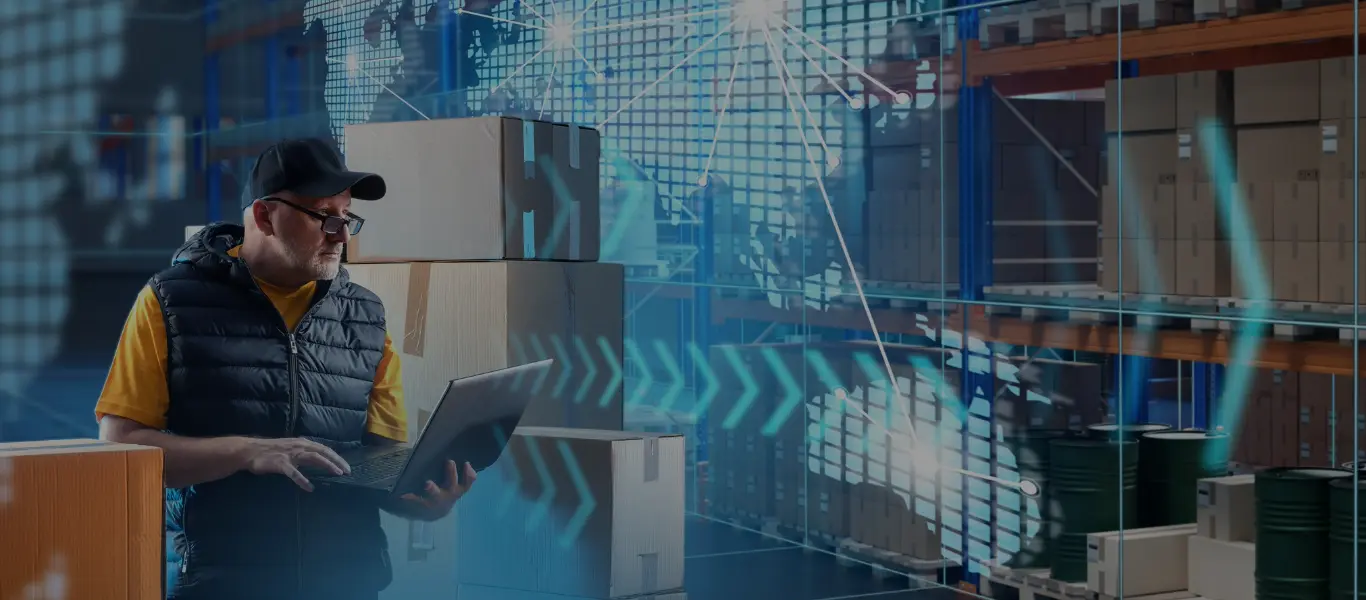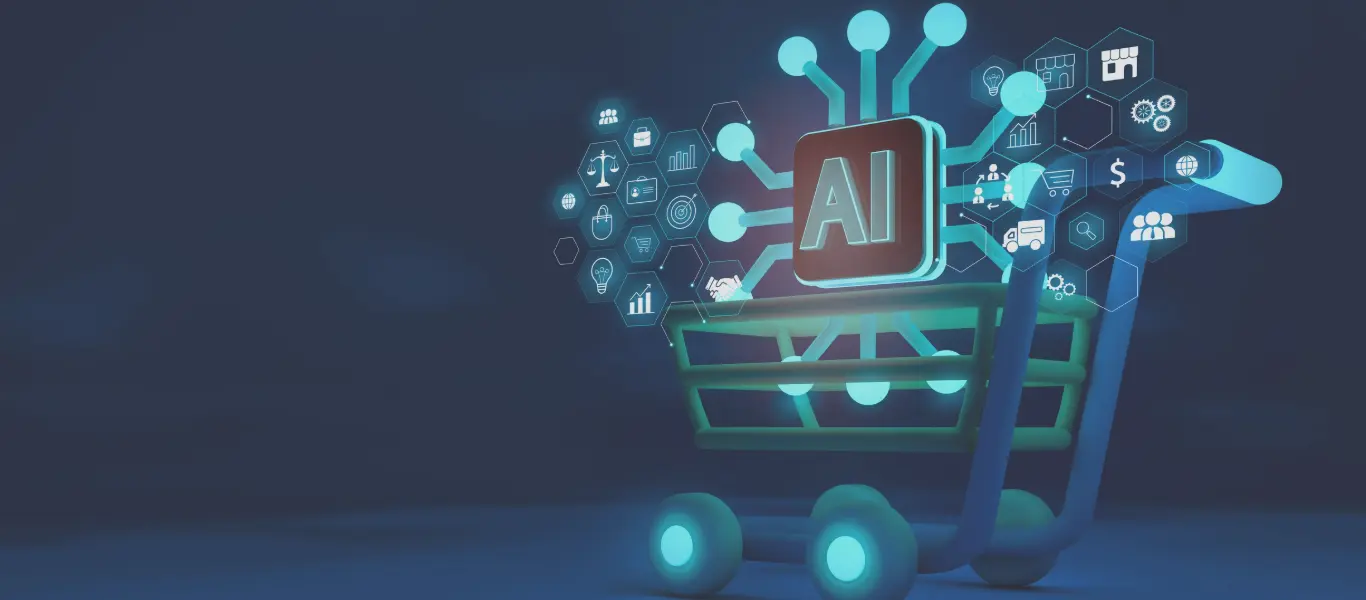In today’s dynamic digital landscape, the importance of choosing the right architecture for your eCommerce cannot be overstated. It directly impacts the ability of your organization to meet its current and future needs, and therefore requires careful deliberation and research to make an informed decision.
In Part 1 of this series, we highlighted the fundamental differences between monolithic, headless, and composable architectures, and provided an overview of the suitability of each to support specific business requirements and goals. And while Part 3 dives into the more strategic and long-term planning considerations involved in choosing the right architecture, here we’ll focus on comparing the 3 architectures across several key dimensions critical to determining which one best fits your business requirements based on your unique circumstances.
COMPARATIVE ANALYSIS
1. Out-of-the-Box (OOTB) Functionality
- Monolithic: All-in-One (AIO) suites come complete with all the most essential features for eCommerce operations pre-integrated, such as product management, order processing, customer service, and payment integration. This usually makes them the easiest to get started on as they require the least upfront development effort.
- Headless: While it typically lacks the extensive OOTB functionality of monolithic platforms, headless usually offers robust back-end capabilities. However, it requires user experience design and extensive development to deliver those capabilities as a compelling customer journey.
- Composable: With its focus on customization and flexibility, composable architecture offers the least OOTB functionality in terms of how we traditionally think about OOTB due to its inherently decoupled nature and uncomposed initial state. However, organizations have the freedom to pick and choose the exact functionalities they want to compose, with the added flexibility of having a wide range of options from third-party vendors in addition to what’s available from their platform vendor.
Key Takeaway: The trade-off for composable’s uncomposed initial state is its unmatched flexibility and customizability. If you have the technical expertise and resources, it can be a powerful tool for building unique and scalable solutions. But if you prioritize ease of use and a tailored user experience with basic functionality, monolithic or headless architectures might be better suited to your needs.
2. Ease of Use
- Monolithic: Offers everything in one place with user-friendly interfaces and pre-built workflows, making AIO platforms suitable for businesses with limited technical expertise or resources.
- Headless: Due to the decoupled architecture and working with APIs, more technical knowledge is required than for monolithic platforms. It requires some development skills for customization and integration but offers lots of flexibility on the frontend and cohesion with the backend, including site administration capabilities, for a more cohesive internal user experience in comparison to composable platforms. However, this can vary greatly from vendor to vendor and is also relative to the technical skills of your team.
- Composable: Due to its modular and decentralized nature, it is the least user-friendly for beginners (but very developer-friendly), and demands the most technical expertise for planning, integration, and management. The components are like Lego blocks that you can pick and choose, and then assemble to compose your desired platform, but it requires expertise in understanding which components to select, how they fit together, and how to configure them to work seamlessly as a whole.
Key Takeaway: Ultimately, the easiest architecture to manage depends on your specific context and priorities. If ease of use is paramount, monolithic might be ideal. If flexibility and customization are crucial, headless or composable could be better options, considering your technical capabilities.
3. Speed and Performance
- Monolithic: While this architecture offers simple setup and management, and built-in optimization tools that enable rapid prototyping and iterations during development that might suit the needs of organizations with consistent website traffic patterns, its inherent limitation with scalability means performance can struggle significantly with traffic spikes or large product catalogs. Furthermore, tight coupling can cause performance issues as updates to one component can affect others.
- Headless: Having a decoupled frontend and backend improves server response times for faster page loads, which also benefits from the API-driven content delivery approach enabled by headless that reduces page weight from smaller content payloads. Lastly, having the ability to choose best-in-class frontend technologies means you can optimize for speed. However, managing separate backend and frontend systems requires more technical expertise, increasing development overhead and complexity, and potentially introducing bottlenecks.
- Composable: Independent microservice architecture offers the ultimate scalability to meet demand, thereby avoiding performance bottlenecks, while also offering the flexibility to integrate a best-of-breed technology stack, where each component can be optimized for performance. However, microservice architecture requires significant technical expertise to design, build, and maintain.
Key Takeaway: When considering website speed and performance, composable offers the most flexibility and potential for optimization but requires significant technical expertise and investment. Headless provides good performance gains and flexibility but increases complexity, and monolithic architecture offers the greatest simplicity, but limitations in scalability and customization hinder performance at scale, especially in fast-moving industries.
4. Scalability
- Monolithic: While it can handle moderate traffic volumes and support basic scaling needs, monolithic architecture is not as flexible as more modern architectures due to the inherent limitations in both horizontal and vertical scalability. The entire system needs to be scaled together, leading to bottlenecks and resource inefficiency, and upgrades often require significant downtime and can be costly. It may also struggle with significant traffic spikes or rapid business growth as changes impact the whole system.
- Headless: Because the frontend and backend are decoupled, they can scale independently based on specific needs, optimizing resource allocation for different demands, and allowing for quicker adjustments to cater to fluctuating traffic or functionality demands — like a surge in traffic on the frontend or adding new functionalities to the backend. However, distributed scaling increases complexity and presents some integration challenges as multiple components must be managed and scaled.
- Composable: Offers the ultimate in granularity and future-proof design as each microservice scales independently, offering unparalleled flexibility and efficiency in handling unpredictable spikes, and its modular nature allows for easy replacement of individual components to quickly adapt to future technology advancements and scalability needs. But with great scalability comes great complexity as higher development and operational expertise are required to manage numerous integrations and microservices.
Key Takeaway: Monolithic architecture is the easiest to deploy initially but offers limited scalability for unpredictable growth and future needs. Headless provides a good balance between flexibility and complexity, allowing for independent scaling of key functionalities. Composable offers the most fine-grained and customizable scaling but demands the most significant expertise and resources.
5. Agility / Innovation / Speed to Market
- Monolithic: Access to pre-built features/functionalities, established best practices, and vendor updates and bug fixes are all pluses, but due to the architecture’s tightly interconnected components, making changes and deploying updates require ‘big bang releases,’ meaning the entire system must be redeployed even for small changes, so testing and release cycles can be lengthy. Vendor lock-in also means that innovation is heavily reliant on the single vendor’s release schedule and priorities, making it challenging, if sometimes impossible, to respond quickly to rapidly changing business requirements.
- Headless: The decoupling of the frontend from the backend allows independent development and deployment cycles, which translates to faster time-to-market for new features and updates to the user interface without impacting the core backend functionality. Furthermore, headless architecture speeds up experimentation with different frontend technologies and frameworks, enabling more tailored and personalized customer experiences quickly, while facilitating the addition of new functionalities through integration of specialized third-party services from best-of-breed vendors. A/B testing different UI elements becomes easier, leading to data-driven decisions for optimizing the user journey, and non-technical business users are provided tools within some headless solutions to make changes (e.g., modify content like text, images, etc. in a headless CMS) without needing coding knowledge or burdening developer resources. On the other hand, integrating multiple services adds development and management overhead, and to some degree, innovation can still depend on a chosen vendor’s release cycles and priorities. Lastly, potential feature gaps could still exist, necessitating finding and integrating services for additional required functionalities.
- Composable: Composable architecture builds on all of the benefits of headless in terms of agility and speed of innovation, but takes things even further with its modular, microservices-based approach, as organizations are free to compose their commerce platform from best-of-breed vendors of their choosing that offer the best leading-edge functionalities that meet their exact requirements. It enables continuous improvement as independent deployments allow incremental innovation and faster feedback loops, and any underperforming or outdated individual service can be easily updated or replaced for rapid improvement. However, these benefits come at the cost of additional complexity, requiring more technical expertise and significant upfront planning, integration, and management effort.
Key Takeaway: Composable architecture offers the highest potential for agility, innovation, and speed to market for new features due to its modularity and flexibility, but it also demands the most significant expertise and effort, and potentially the longest initial setup unless adopting an incremental approach. A headless approach provides greater agility with faster customization and feature development than monolithic solutions can offer, but it, too, requires managing some complexity and finding suitable services. Monoliths are the least agile option due to their tightly coupled nature, which is problematic for fast-growing companies, but they can be faster for initial implementation and offer the greatest simplicity with the most out-of-the-box features and functionality.
6. Omnichannel Support
- Monolithic: While having pre-built features for managing multiple sales channels within a single, unified platform is simpler and easier to maintain initially, the rigidity of having tightly coupled components makes it difficult to optimize experiences for each channel as changes require updating the entire system, and any performance bottlenecks will affect all channels equally. Most monolithic systems offer pre-built channel frontends for web and mobile, but few are built to be truly omnichannel.
- Headless: Having a decoupled frontend and API-driven integration enables customization for specific channel needs and the ability to integrate with various channel-specific solutions. However, separate development is required for each channel, increasing development complexity and managing numerous integrations can be cumbersome. However, the ability to use an All-in-One backend with fully baked capabilities, and easily extend it to multiple channels, is the biggest advantage of headless over AOI suites and the primary reason any organizations employ a headless approach.
- Composable: Enables tailored integrations for each channel with optimal functionality by leveraging best-of-breed microservices-based solutions. Individual services scale based on specific channel demands. However, integration is more complex, requiring intricate orchestration and data flow management, and maintaining consistent data and security across providers needs careful planning and potentially presents greater governance challenges.
Key Takeaway: Composable architecture offers superior omnichannel support with the ability to deliver seamless and tailored integrations, flexible scaling, and consistent experiences across any channel. But that doesn’t make it the right choice for every company, and this is where headless really shines, offering good flexibility for diverse integrations while being easier to manage than composable. Monolithic architecture is the least suited of the three for true omnichannel support, lacking in adaptability to different channels and scalability.
7. Flexibility / Customizability
- Monolithic: Having the greatest amount of pre-built functionality out-of-the-box quickly covers basic needs, reducing upfront development time and customization costs. Built-in integrations for things like common payment gateways and shipping providers minimize the need for custom APIs. However, the architecture’s all-in-one, predefined nature restricts customization freedom, making it more difficult to tailor the platform to unique business requirements, meet unexpected future needs, or offer a differentiated brand experience. Lastly, modifying core functionalities often requires complex code changes, slowing down innovation.
- Headless: The ability to interact with data and logic through APIs enables custom integrations and unique user experiences, and the decoupled nature of the architecture offers greater flexibility owing to the ability to leverage different tools for the frontend and backend based on your specific needs. But building and maintaining custom APIs for various services adds complexity and development effort, requiring skilled developers to handle API integrations and custom functionality.
- Composable: Modular microservices allow you to easily swap, replace, or add microservices to tailor your platform to any unique need or future trend with unmatched customizability to build an eCommerce experience completely tailored to your brand and customer journey. That said, managing numerous, interconnected microservices requires significant expertise and resources, and there’s an increased risk for fragmentation as ensuring cohesion and data consistency across independent services can be more challenging.
Key Takeaway: Composable offers ultimate flexibility but demands high development expertise and resources. Headless provides good customization possibilities through APIs and third-party tools while requiring moderate development skills. And a monolithic platform is the easiest to start with but offers limited customization options that restrict brand differentiation and future adaptability. Ultimately, the optimal choice depends on your specific needs and resources, considering factors like brand differentiation, development capabilities, and budget constraints, but an architecture that can adapt and evolve as your business grows is highly desirable.
8. Security and Compliance
- Monolithic: Robust security features and compliance certifications are more easily implemented and enforced in a single, unified platform with a centralized security infrastructure; however, this can become more challenging as the platform grows. And with one codebase to secure, there’s a smaller attack surface exposed to hackers, but on the other hand, a single point of failure can compromise the entire system if there’s a breach.
- Headless: Offers more security resilience due to component isolation and flexibility in compliance, but managing security across multiple services increases complexity.
- Composable: Provides the highest potential for security and granular compliance due to best-of-breed choices and control but demands significant expertise and resources for effective implementation.
Key Takeaway: Each architecture has its own security and compliance trade-offs, so the specific regulations governing your industry, your technical capabilities, and risk tolerance, will determine the best fit for your business. It’s crucial to conduct thorough security assessments and implement robust security practices regardless of the chosen architecture.

OTHER CONSIDERATIONS
When evaluating which architecture will best serve your needs, you must consider your specific goals and priorities, the complexity of your business, your omnichannel strategy, technical expertise and resource availability, integration and customization needs, personalization goals, anticipated future needs, and budget. There’s no one-size-fits-all solution, and the optimal choice depends on your unique business context.
Continue to Part 3 for a comparative analysis of the 3 architectures across the following 6 dimensions relevant to your strategic and long-term planning considerations:
- Integration Complexity
- Development Resource Requirements
- Migration Change Management
- Upgrading & Future-Proofing
- Vendor Support
- Cost
About SkillNet, Makers of Modern Commerce
SkillNet Solutions provides consulting and technology services to companies that want to digitally transform their businesses. We can optimize your traditional (monolithic) legacy platforms or implement/migrate to modern headless or composable commerce solutions to enable the flexibility and agility to meet your customers wherever they are, and rapidly respond to sudden shifts in consumer behavior. We also offer Application Management Services (AMS) and can provide skilled resources to serve as an extension of your team to help support and maintain your eCommerce platform.
Located in the heart of Silicon Valley, SkillNet partners with industry leaders like Oracle, SAP Commerce Cloud (Hybris), commercetools, Salesforce, Spryker, VTEX, Contentstack, Cloudinary, Mirakl, and AWS to enhance online and in-store experiences. Since 1996, we have partnered with enterprise clients across 63 countries to drive exceptional customer experiences and growth. Our award-winning solutions have enabled global brands to deliver the promise of modern commerce.















